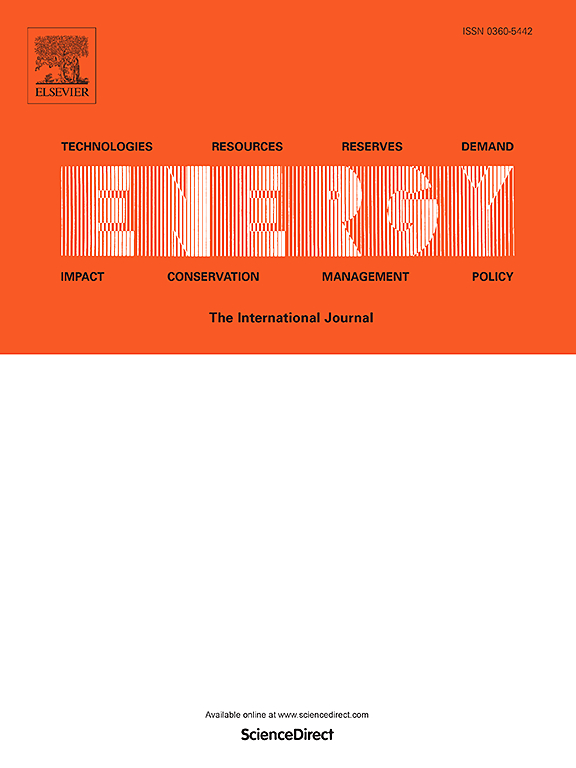A comprehensive feasibility evaluation of hydrogen-carbon-salt cavern-renewable energy (HCSR) system
IF 9
1区 工程技术
Q1 ENERGY & FUELS
引用次数: 0
Abstract
Renewable energy utilization, hydrogen energy development, and carbon emissions reduction are crucial methods to build a green and clean society. However, the problems with the large scale of energy utilization and storage efficiency restrict the growth of the above methods. To solve these problems, a hydrogen-carbon-salt cavern-renewable energy (HCSR) system that produces and stores the CH4, CH3OH, CO, and petrol was proposed based on the principle of power to gas (PtG). To analyze the feasibility of the HCSR system, a comprehensive evaluation system that includes three evaluation models (economy model, geological stability, and environment model) was built. The application prospect, energy conversion, system sensitivity, and system limitations were discussed. The study showed that the HCSR system (power to petrol) can save and dollars compared to the surface storage tanks and rock cavern storage in 2024, and the economy of the HCSR system was greater than other traditional systems. The maximum displacement, effective strain, and dilatancy of the salt cavern energy storage (SCES) in salt caverns with interlayers were 4.5 m, 0.18 , and 0.4 , respectively, and these parameters satisfy the stability criteria. The maximum environmental parameters of the HCSR system were the zero-carbon circulation and utilization of renewable energy, which account for 43.06 % and 23.12 %. Geological stability was the most sensitive parameter (54.13 %) in the HCSR system. The system will contribute to the development of zero-carbon circulation and energy transition.
氢-碳-盐洞穴-可再生能源(HCSR)系统综合可行性评价
利用可再生能源、开发氢能、减少碳排放是建设绿色清洁社会的重要途径。然而,能源利用的大规模和存储效率的问题制约了上述方法的发展。为了解决这些问题,基于电能制气(PtG)的原理,提出了一种生产和储存CH4、CH3OH、CO和汽油的氢-碳盐洞穴可再生能源(HCSR)系统。为了分析HCSR系统的可行性,构建了包括经济模型、地质稳定性模型和环境模型三种评价模型的综合评价体系。讨论了其应用前景、能量转换、系统灵敏度和系统局限性。研究表明,到2024年,与地面储罐和岩洞储罐相比,HCSR系统(电力转汽油)可节省1.68×1010dollars和1.79×1010美元,并且HCSR系统的经济性高于其他传统系统。夹层盐洞储能的最大位移、有效应变和剪胀量分别为4.5 m、0.18 m和0.4 m,满足稳定性准则。HCSR系统的最大环境参数为可再生能源的零碳循环和利用,分别占43.06%和23.12%。地质稳定性是HCSR系统中最敏感的参数(54.13%)。该系统将有助于零碳循环和能源转型的发展。
本文章由计算机程序翻译,如有差异,请以英文原文为准。
求助全文
约1分钟内获得全文
求助全文
来源期刊

Energy
工程技术-能源与燃料
CiteScore
15.30
自引率
14.40%
发文量
0
审稿时长
14.2 weeks
期刊介绍:
Energy is a multidisciplinary, international journal that publishes research and analysis in the field of energy engineering. Our aim is to become a leading peer-reviewed platform and a trusted source of information for energy-related topics.
The journal covers a range of areas including mechanical engineering, thermal sciences, and energy analysis. We are particularly interested in research on energy modelling, prediction, integrated energy systems, planning, and management.
Additionally, we welcome papers on energy conservation, efficiency, biomass and bioenergy, renewable energy, electricity supply and demand, energy storage, buildings, and economic and policy issues. These topics should align with our broader multidisciplinary focus.
 求助内容:
求助内容: 应助结果提醒方式:
应助结果提醒方式:


